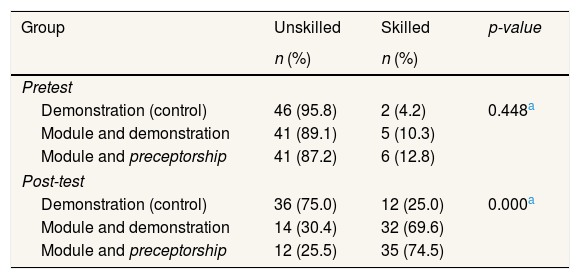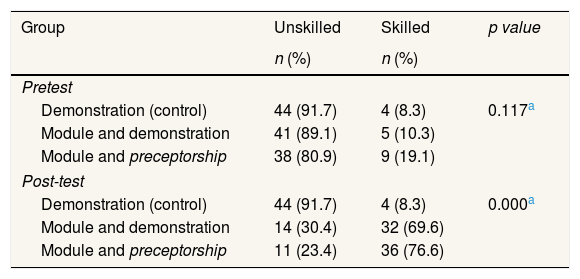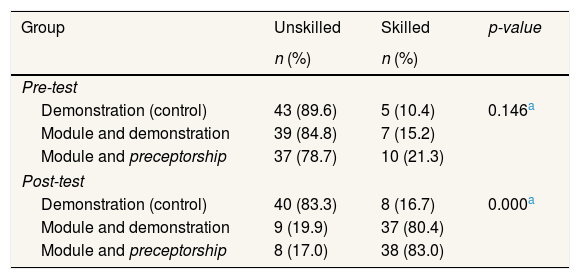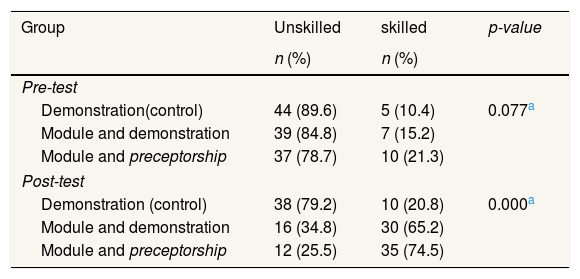
The 3rd International Nursing and Health Sciences Students and Health Care Professionals Conference (INHSP)
More infoThis study aims to determine the effect of the module through the preceptorship method on the improvement of stage IV childbirth care skills of D-III Midwifery students in childbirth care courses.
MethodsThis study used a Quasi Experiment (pre-test post-test control group design). The population of all students who program the subject of childbirth care is 141 students. The sampling technique used total sampling. The sample was 141 semester II students at Program study of D-III Midwifery, STIKES Pelamonia Kesdam VII Wirabuana. Previously, a pre-test was carried out on stage IV childbirth care skills then divided into modules. After that, the preceptorship method was carried out for three meetings with 2×50min at each meeting. At the end of the meeting, a post-test was conducted. Data were analyzed using Mann–Whitney.
ResultsThis study indicates a significant effect, the value (p=0.000, p<0.05) in improving the skills of D-III midwifery students in semester II regarding stage IV delivery care in the module group and the preceptorship method compared to the demonstration and module groups.
ConclusionThe results of data analysis and evaluation results on the module and preceptorship method significantly increase stage IV childbirth care skills for D-III midwifery students.
The module is an independent learning package that includes a series of learning experiences that are planned and systematically designed to help students achieve their learning goals (Jumiyati, Nugrahaeni, and Margawati, 2014). The purpose of the module is to be used appropriately and variedly gives researchers the idea of creating modules that can increase student motivation and enthusiasm for learning. Thus, students can learn independently according to the abilities they are interested in and allow students to evaluate their learning outcomes.1 It is hoped that the module can replace teachers, instructors, or lecturers (educators) in the classroom.2 Here, the researcher is motivated to develop a learning module for stage IV childbirth care.
Preceptorship is a vital component in preparing midwifery students for professionalism.3 Preceptorship is a learning method that prioritizes emotional support and motivation, in which midwives as experienced roles act as role models.4 According to Tursina et al. (2016), preceptorship can change a new midwife or student to become a professional midwife.5 Clinical learning requires interaction between students and preceptors by using clinical learning modules, and this can increase competence for students, especially DIII midwifery.6–8
The advantages of using the preceptorship model can be felt for preceptors, preceptors, professions, and patients.5,9,10 preceptorship aims to introduce a real work environment to midwifery students.11 The role of preceptorship in developing professional skills and attitudes, providing knowledge, forming student psychomotor skills, the role of preceptors as role models so that they can show the quality of professional midwives and determine students as professional midwives.12 Based on the research results, the applied preceptorship method can increase the competence achievement of students in the discipline.13 Similar research shows that the preceptorship method helps the learning process make students skilled and confident. However, what can support this is a trained and experienced preceptorship so that it is able to make students feel comfortable interacting with the preceptor.14
MethodsThis study's module, demonstration, and preceptorship methods are independent variables, while the fourth stage, childbirth care skills, is the dependent variable. This study consisted of two groups, including the control group and the intervention group. The intervention group consisted of two, namely the implementation of the stage IV childbirth care module and demonstration by implementing the module with the preceptorship method, which was held three times in the laboratory with 2×50min at a meeting. This research was conducted from November to December 2019 and has received approval from the ethics commission number 1044/UN4.6.45.31/pp36/2019.
The population in this study were all STIKES students of the Pelamonia Kesdam Wirabuana semester II midwifery study program, which programmed the maternity care courses with 141 students. The sampling technique in this research is the total sampling technique.
This research is an experimental study, namely research conducted with intervention on research subjects and then the effect of the intervention is measured and analyzed. This type of research Quasi Experiment (pre-test post-test control group design), namely research with a control group, cannot fully function to control external variables that affect the implementation of the experiment. The results of the analysis are displayed in narrative or table form. The analysis in this study used the Mann–Whitney statistical test.
The researcher used a computerized Program Statistics Product and Service Solution (SPSS) IBM type 25. Data analysis used univariate analysis to determine the frequency distribution and bivariate analysis to determine the effect of the intervention on the group, then the results of the analysis were described in the form of narratives, tables, and diagrams.
ResultsThe results of this study are presented in several tables as follows.
The results of the analysis show that postpartum procedure skills during the IV stage of normal delivery have increased with proven values (p=0.000, p<0.05) (Table 1). Before the intervention, students’ skills were in the unskilled category (95.8%) in the skilled demonstration group (4.2%), and after learning demonstration, methods increased (25.0%) skilled students. The module and demonstration groups who were unskilled (89.1%) and those skilled in performing postpartum procedures (10.3%) then improved better to become (69.6%) skilled students. On the other hand, in the module group and the preceptorship method before the intervention, only 12.8% were skilled and increased after the intervention (74.5%) were skilled at performing postpartum procedures.
Skills differences in performing postpartum procedures before and after intervention in the intervention group and group.
| Group | Unskilled | Skilled | p-value |
|---|---|---|---|
| n (%) | n (%) | ||
| Pretest | |||
| Demonstration (control) | 46 (95.8) | 2 (4.2) | 0.448a |
| Module and demonstration | 41 (89.1) | 5 (10.3) | |
| Module and preceptorship | 41 (87.2) | 6 (12.8) | |
| Post-test | |||
| Demonstration (control) | 36 (75.0) | 12 (25.0) | 0.000a |
| Module and demonstration | 14 (30.4) | 32 (69.6) | |
| Module and preceptorship | 12 (25.5) | 35 (74.5) | |
The results of analysis 2 show that the skills of students in postpartum evaluation procedures have increased with proven values (p=0.000, p<0.05) (Table 2). Before the intervention was carried out on students, the skills possessed were in the unskilled category, and only 91.7% of the demonstration group were skilled at performing postpartum evaluation procedures and skilled students (8.3%) then after the demonstration method was carried out at this stage it remained the same (8.3%)) the skilled and unskilled (91.7%). In the module and demonstration groups before the intervention (89.1%), students were unskilled and skilled only (10.3%). After intervention in the module and demonstration groups, the data showed changes in unskilled (30.4%) and skilled students (69.6%). Whereas in the module group and the preceptorship method, there was an increase more than the module and demonstration group seen from the unskilled data, namely (23.4%) and skilled students (76.6%).
Differences in postpartum evaluation skills before and after intervention in the intervention group and the group.
| Group | Unskilled | Skilled | p value |
|---|---|---|---|
| n (%) | n (%) | ||
| Pretest | |||
| Demonstration (control) | 44 (91.7) | 4 (8.3) | 0.117a |
| Module and demonstration | 41 (89.1) | 5 (10.3) | |
| Module and preceptorship | 38 (80.9) | 9 (19.1) | |
| Post-test | |||
| Demonstration (control) | 44 (91.7) | 4 (8.3) | 0.000a |
| Module and demonstration | 14 (30.4) | 32 (69.6) | |
| Module and preceptorship | 11 (23.4) | 36 (76.6) | |
The results of the analysis show that the skills of students in postpartum evaluation procedures have increased with proven values (p=0.000, p<0.05) (Table 3). Before the intervention was carried out on students, the skills possessed were in the unskilled category (89.6%), and only those who were skilled (10.4%) were in the demonstration group. After the intervention method demonstration, there were still many unskilled students (83.3%) and skilled students. Only (16.7%). In the module and demonstration group before the intervention (84.8%), students were unskilled and skilled only (15.2%), then after module intervention and demonstration methods were unskilled students only (19.9%) and skilled students increased rapidly to (80.4%) %). Whereas in the module group and preceptorship method before the intervention, unskilled students (78.7%) and only skilled (21.3%), after the module intervention and preceptorship, the unskilled (17.0%) and the skilled increased to (83.0%).
Differences in postpartum hygiene and safety skills before and after intervention in the intervention group and group.
| Group | Unskilled | Skilled | p-value |
|---|---|---|---|
| n (%) | n (%) | ||
| Pre-test | |||
| Demonstration (control) | 43 (89.6) | 5 (10.4) | 0.146a |
| Module and demonstration | 39 (84.8) | 7 (15.2) | |
| Module and preceptorship | 37 (78.7) | 10 (21.3) | |
| Post-test | |||
| Demonstration (control) | 40 (83.3) | 8 (16.7) | 0.000a |
| Module and demonstration | 9 (19.9) | 37 (80.4) | |
| Module and preceptorship | 8 (17.0) | 38 (83.0) | |
The results of the analysis show that the skills of students in postpartum documentation have increased with proven values (p=0.000, p<0.05) (Table 4). In the demonstration group before the intervention, the skills of students were still low. The skilled ones were proven by the data (89.6%) who were unskilled and skilled only (10.4%), but after the demonstration method intervention, there was a slight increase in skilled (20.8%) and unskilled ones became (79.2%). In the module and demonstration method groups before the intervention, the unskilled (84.8%) and the skilled (15.2%) after the intervention increased to (65.2%) skilled and unskilled (34.8%). While the module group and the preceptorship method before the intervention of unskilled students (78.7%) and skilled (21.3%) then after the intervention there was an increase in skilled (74.5%) and unskilled (25.5%).
Differences in postpartum documentation skills before and after intervention in the intervention group and group.
| Group | Unskilled | skilled | p-value |
|---|---|---|---|
| n (%) | n (%) | ||
| Pre-test | |||
| Demonstration(control) | 44 (89.6) | 5 (10.4) | 0.077a |
| Module and demonstration | 39 (84.8) | 7 (15.2) | |
| Module and preceptorship | 37 (78.7) | 10 (21.3) | |
| Post-test | |||
| Demonstration (control) | 38 (79.2) | 10 (20.8) | 0.000a |
| Module and demonstration | 16 (34.8) | 30 (65.2) | |
| Module and preceptorship | 12 (25.5) | 35 (74.5) | |
The results of the research conducted showed that there was a significant increase in students’ skills regarding postpartum procedures marked by a value (p=0.000, p<0.05), thus the study assumes that modules and preceptorship methods can be used to improve student skills, this happens because Students are given modules first to be able to study independently. During the learning process, students’ preceptorship is made in small groups so that the learning process is more focused and well-organized. The first meeting in student research is given the material on stage IV childbirth care and is supported by modules that have been studied. After that, the preceptor provides direct feedback to help students correct the mistakes made so that the module and the role of the preceptor are very influential in the guidance process.
This assumption is supported by research by Pujiastuti (2019), which suggests that the supervisor's task is to provide encouragement and facilitators to improve student skills and professionalism.11 Then, it is explained that the student's success process in learning is strongly influenced by the role of the clinical supervisor or preceptor.5,15 The demonstration method is used by STIKES D-III midwifery study program Kesdam VII Wirabuana Makassar in practicum learning in the laboratory. This demonstration method has long been used, and this method is to demonstrate to students an action, work procedure, or situation to be studied. In this demonstration method, students can directly see the lecturer practicing the activities, besides the equipment, and everything that requires accuracy can be seen immediately without guessing.16
The learning process through direct experience or practice provides satisfactory learning outcomes for students when compared to learning in the classroom. This process focuses on the same learning experience as what a medical professional would have. The learning process is carried out in a holistic manner which requires transfer, organization, application, and synthesis of the previously learned people.17 The skills of students in this study before the intervention in stage IV childbirth care procedures showed no significant change in the three groups. In this case, the three groups had not been given demonstration methods, modules, and preceptorship methods for student skills. After the intervention was carried out in each group compared to the control group, who got the demonstration method only without modules, by being given teaching modules, students could be motivated and have an attraction when studying modules independently and practicing independently.18 When students are ready before learning in the laboratory, students are confident when practicing in the laboratory because they have studied the modules that have been given.19
The module provides an increase in this research. It is seen from the results of the analysis data that there has been a very significant increase in the module group and demonstration method as well as the module group and preceptorship method. This research is supported by the research conducted.20 Preceptorship can increase student self-efficacy and learning outcomes. Research in Sweden has seen changes in increased student competence, including cognitive and psychomotor, which are much better after applying the preceptorship method.15
The results of this study indicate a significant increase in student skills in carrying out work procedures for stage IV childbirth care, with the module learning media provided.21 The preceptorship method provides a clinical learning experience through a good role model. Students will imitate the critical thinking patterns carried out by preceptors when providing normal delivery care when practicing in laboratories and clinical practice fields.22 The preceptee has the potential to facilitate the clinical experience of the preceptee by encouraging reflection and enhancing the preceptee's critical thinking ability. The preceptorship learning method has been considered an attractive clinical teaching strategy and can improve students’ skills.10
The preceptorship learning method is a shared responsibility between midwifery education institutions and health service agencies to bridge the gap between theory and practice. This preceptorship is included to facilitate the student's transition period in increasing competence and self-confidence. The role of the preceptor as a role model is one of the most effective learning strategies used in the preceptorship program.23
Based on Tables 1–4, shows that the skills of STIKES students in the second semester of midwifery study programs to take care of stage IV childbirth have increased in skills, namely the module group and the preceptorship method. Carry out postpartum procedures (74.5%) skilled students, then perform postpartum evaluation (76.6%), skilled students, perform hygiene and safety procedures after delivery (83.0%) skilled students and postpartum documentation skills (74.5%) skilled student. It can be seen in Tables 1–4 a significant increase in the data analysis above.
The results of research conducted by Tursina et al. (2016) show that good preceptorship and conventional guidance affect improving clinical competence as measured by the clinical competency questionnaire (KKK).5 The average pre-test score in the experimental group is lower than the control group; this can be interpreted that the initial ability of students when doing clinical practice is better in the control group than in the experimental group. The research mentioned that out of 76 preceptors who had more than ten years of experience at Sultan Qaboos University Hospital in 2011, 87% of respondents stated that in the preceptorship, the duties and responsibilities of the preceptors are very important to improve student competence to become nurses professional.24
The results of this study are in line with research conducted by Wardani (2018) regarding the results of the research and data analysis that has been carried out about the effect of feedback using preceptorship learning methods on the physical examination skills of pregnant women.8 So, it can be concluded that by giving direct and video feedback using the preceptorship learning method, these two groups have the same effect on improving the physical examination skills of pregnant women.
ConclusionThe results of this study indicate that there is a significant effect, the value (p=0.000; p<0.05) improves the skills of D-III Midwifery students in semester II regarding stage IV delivery care in the module group and the preceptorship method compared to the demonstration and module groups.
Conflicts of interestThe authors declare no conflict of interest.
Peer-review under responsibility of the scientific committee of the 3rd International Nursing, Health Science Students & Health Care Professionals Conference. Full-text and the content of it is under responsibility of authors of the article.


















